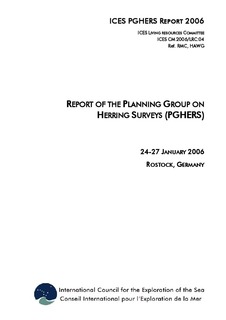| dc.description.abstract | REVIEW OF LARVAE SURVEYS IN 2005/2006: At the time of writing two of the seven surveys in
the North Sea remained to be carried out in January 2006. Results will be ready for the
Herring Assessment Working Group (HAWG) meeting in March 2005.
COORDINATION OF LARVAE SURVEYS FOR 2006/2007: In the 2006/2007 period, the Netherlands
and Germany will undertake seven larvae surveys in the North Sea from 1 September 2005 to
31 January 2006. Germany will contribute a second vessel to the IHLS to ensure coverage in
the Orkney and Buchan area, which has not been covered in recent years; this will also take
place in the first half of September. Thus, with the combined effort of Germany and
Netherlands an almost complete coverage of the main spawning grounds is achievable. The
Baltic Sea Fisheries Institute will continue with the larvae survey in the Greifswalder Bodden
area in 2006.
NORTH SEA ACOUSTIC SURVEYS IN 2005: Six acoustic surveys were carried out during late June
and July 2005 covering the North Sea and west of Scotland. The provisional total combined
estimate of North Sea spawning stock biomass (SSB) is 1.9 million t, a decrease from 2.6
million t in 2004. The stock is dominated by the 2000 year class. Growth of the 2000 year
class seems again to be slower than average: 96% is mature. The west of Scotland SSB
estimate is 190,000 t (400,000 t in 2004); this is a substantial reduction from last years
estimate. The surveys are reported individually in Annex 2.
WESTERN BALTIC ACOUSTIC SURVEYS IN 2005: A joint German-Danish acoustic survey was carried
out with RV “Solea” from 4 to 21 October in the Western Baltic. The estimate of Western
Baltic spring spawning herring SSB is 197,700 t (192,100 t in 2004). A full survey report is
given in Annex 3.
MANUALS FOR ACOUSTIC AND HERRING LARVAE SURVEYS: The manual for herring acoustic surveys
in ICES Divisions III, IV, and VIA will be reviewed and updated in 2006 by correspondence.
Development of the equipment used, has been extensive in recent years: an extensive review
is, therefore, required: there was not enough time to carry out this activity at the meeting. The
manual for the International Herring Larvae Surveys south of 62° north has been reviewed
and updated. Version 2 of the manual is attached in Annex 5.
STATUE AND FUTURE OF THE FISHFRAME AND HERSUR DATABASE: The status of the
HERSUR database has not changed since 2005. Only Denmark has uploaded new data. Three
countries have uploaded aggregated (“stage 3”) data in the Fishframe database. The
international data set was completed by extracting national input data from the excel sheet
used so far. The calculation, aggregation and reporting procedures on uploaded data of 2003,
2004 and 2005 was tested against the old procedure. The minor differences found were caused
by differences in precision. It was decided that the Fishframe stage 3 module will be used to
aggregate data from the 2006 surveys at the next meeting in 2007. To ensure that all countries
confirm to same methods in stage 2, a group to design the user requirement specifications
should be formed and meet during 13–14 June 2006 at DIFRES in Copenhagen.
SPRAT: Data on sprat were available from RV “Walther Herwig” III, RV “Tridens” and RV
“Dana”. The total sprat biomass was estimated as 562,000 t in the North Sea (up from 360,000
t in 2004) and 59,800 t in the Kattegat (up from 15,000 t in 2004). The present data suggest
that sprat abundance is decreasing in the south and the distribution limit might therefore have
been reached.
COORDINATION OF ACOUSTIC SURVEYS IN 2006: Six acoustic surveys will be carried out in the
North Sea and west of Scotland in 2006 between 25 June and 30 July. Participants are referred
to Figure 4.4.1 for indications of survey boundaries. “Tridens” and “Walther Herwig” will cover the area between 52º and 57º together with interlaced transects. A survey of the western
Baltic and southern part of Kattegat will be carried out by a German research vessel in
October.
LARVAE SURVEY SAMPLER: In the sampling period 2004-2005 the Netherlands changed from a
Gulf III to a Gulf VII plankton torpedo. The Gulf VII seems to perform better in that the
oblique hauls show a sharp ‘V’-shape. Possible differences between these two sampling
devices will be investigated by sampling simultaneously with the Gulf III and Gulf VII during
the September 2006 survey. A special set-up will be tested and improved during a survey in
May targeting spawning horse mackerel in the southern North Sea. If the tests during the May
survey prove successful, the apparatus will be used during the herring larvae survey in
September 2006 to obtain a set of intercalibration hauls.
REVIEW OF THE AGE READING WORKSHOP AT THE ARCHIPELAGO RESEARCH INSTITUTE ON THE ISLAND OF SEILI, FINLAND ON 6–JUNE 2005: Thirty-five participants from 25 countries attended
the Age Reading Workshop to identify present problems in herring age determination,
improve the accuracy and precision of age determinations and spread information of the
methods and procedures used in different ageing laboratories working with herring. The main
conclusion was that it is recommended that regular otolith exchanges take place between
institutes in order to detect precision drift in the age estimations.
EVALUATING THE POTENTIAN OF THE TORRY FISH FAT METER FOR MEASURING LIPID CONTENT OF HERRING AT SEA: Deborah Davidson from the University of Aberdeen gave a presentation of her
ongoing PhD study examining the fat content in herring (see working document in Annex 7).
The overall aim of the field study in 2006 is to determine whether lipids impose a threshold on
the onset of maturation in North Sea herring. PGHERS recommends that in the 2006 North
Sea acoustic surveys, all participants take a student from Aberdeen University to make
measurements of the fat content of herring. | en |
